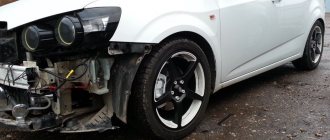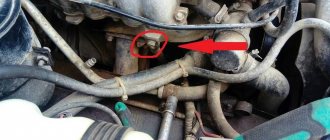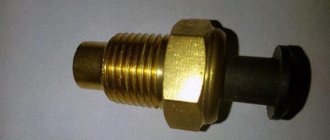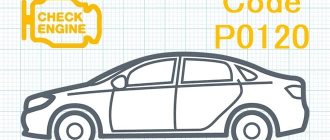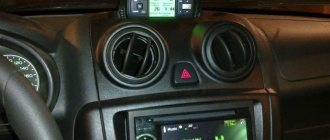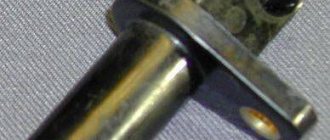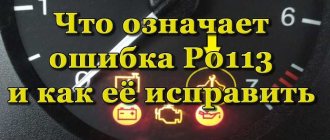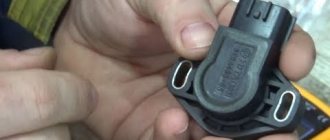When previously unknown symbols and signs suddenly appear on the instrument panel, these are most likely messages from the on-board computer about problems that have arisen in one of the car’s systems. The ability to correctly decipher these messages allows you to promptly identify and get rid of problems that have arisen. With the advent of new Chevrolet models, decoding is becoming increasingly difficult, as their number increases.
For correct recognition, it is best to perform diagnostics using special equipment, or check messages on the car’s dashboard. Models have appeared in which a message is displayed instead of a code. For example, a message may appear indicating that the time for changing the engine oil is approaching, or other similar messages. To find out in more detail about the problems that have arisen, it is best to use a special scanner.
They are a small computer in which a special program is installed, with its help the machine can be independently diagnosed. There are two types of such scanners:
Error codes - decoding
Code Information message 15 High brake light malfunction 16 Perform brake light service 18 Left low beam malfunction 19 Rear fog lamp malfunction 20 Right low beam malfunction 21 Left front parking light malfunction 22 Right front parking light malfunction 23 Reversing lamp malfunction 24 Malfunction license plate light 25 Left front turn signal malfunction 26 Left rear turn signal malfunction 27 Right front turn signal malfunction 28 Right rear turn signal malfunction 84 Engine power has decreased 89 Vehicle will need to be serviced soon
Cheap solution, my problem
I didn’t specifically combine them with the first four; I want to dwell on my problem in more detail. One more warning - before you get into your brains and electronics, let’s remove the battery terminals!
In general, my diagnostician was “from God,” as they say in Chevrolet and Opel, “he ate the dog,” he even worked for the officials for a year, but then he was laid off (GM left Russia). He has a professional scanner, costing 160,000 “our wooden ones”, and he updates the firmware on it every year (about another $300 - $400) - the balalaika is not cheap. Here is a photo.
But as he says, all the latest changes and information on new car models appear immediately (not only GM, all cars from our TAZOVs to Infinity). Not one ELM 327 (from China) has such information, and certainly not! Who will “cover” the annual firmware? That's why many Chinese scanners have errors - CAN'T READ!
Diagnostics - he connected his “miracle device” and it showed that it was not a choke! Wow, a stone just fell from my soul, it revealed that it was a pedal! To hell with it, I’ll buy a new one for only 3,000 rubles, and replace it myself in a couple of minutes, unscrew one bolt, remove it and connect the cable.
However, the diagnostician told me - let's try to restore this one, if the error goes away then the pedal will be 100%, and then you will decide whether to buy a new one or drive on this one for a while. Okay, I agreed. But first he says - I’ll measure all the circuits - with a multimeter, I didn’t delve further, but it turned out that the pedal does not give any breaks! Unclear! It turns out she's whole?!
He tells me this - he recently came to see me in an Astra, code 84 + ESP was also on, in the end the contact on the ECU oxidized, they cleaned it, and everything worked like clockwork. Let's take a look at you. The 6 Volt load comes from there.
In the end, I didn't have to buy anything! The cost of repairs + diagnostics is 1500 rubles - SATISFIED AS AN ELEPHANT! The master noticed that the voltage at the ECU contacts is only about 3 - 5 Volts (there are a lot of them), therefore - YOU SHOULD NOT APPLY ANY LIQUIDS TO IMPROVE CONTACTS, such as terminal protection, etc. This way you can sag the voltage and simply burn out the ECU! You just need cleaning, it is advisable not to damage the protective coating of the contact (wipe with alcohol - carefully), then blow everything off with compressed air.
The moral of this story is that, after reading on the forum, I almost removed the throttle and disassembled it! Although it wasn’t worth doing this (specifically on my AVEO)!
GUYS FIRST, LET'S GO TO A DIAGNOSIS - A GOOD DIAGNOSIS! And then we’ll self-medicate (otherwise you might end up doing a lot of things). And yes, again, from the first steps, after adding antifreeze (if the level is gone), look at the contacts on the ECU, clean them - perhaps the problem will be solved. We rode with the master for about 5 - 10 kilometers, no mistakes!
This is the story, I hope it helped! I tried to put it on the shelves as much as possible, there is information on the Internet on forums, but it varies everywhere, there is no common denominator - maybe this, or maybe that! Check all the devices that I described to you - the error will go away in 95% of cases.
PS People for those who are looking for a diagnostician in Ulyanovsk - I’m writing my own, his name is Alexey, mobile - 8 (909) 3602112. Really, smart guy!
(24 votes, average: 4.96 out of 5)
Similar news
Do-it-yourself windshield polishing. In different ways + pass.
How often should you change the fuel filter? Let's analyze a separate varia.
How to remove the bumper of a Hyundai Solaris. Let's disassemble the front part, photo.
Communities › Chevrolet Aveo and Sonic (2nd generation) › Blog › Decoding Chevrolet AVEO error codes. Code Description 15 High brake light faulty 16 Service brake lights 18 Low beam faulty.
Error codes - decoding - chevrolet aveo club forum. Issue 18 Chevrolet Aveo 2012 sonic t300 - interior lighting part 2. Deciphering Chevrolet Niva error codes.
II generation 2012 Codes of information messages that are displayed on the dashboard of the Chevrolet Aveo 2.
We also ask you to let us know if you have any problems playing the video. While driving, the traction disappeared, the dashboard began to flash, the automatic transmission went into emergency mode. Error codes - decoding - chevrolet aveo club forum. Search this forum only?.
What is the reason for the errors?
There are a lot of reasons, but it’s worth noting that they are not always critical, so you shouldn’t buy spare parts right away!
Guys, I want to warn you - before sounding the alarm, you must first look for an intelligent diagnostician and only then draw conclusions! After all, my problem was not at all with the throttle. But this became clear later.
Precisely a smart one with a good scanner, who understands your Chevrolet or Opel, because if you connect a cheap scanner like ELM 327, then it simply may not detect the error!
SO, what problems there may be, I’ll start with, perhaps, the most harmless one:
Probably intrigued. To be honest, the diagnostician struggled with the car for almost a day. But I found a problem.
Error 84, 89, ABS or ESP may be on. Appears on Chevrolet Aveo, Cruze, Opel Astra J cars
Not long ago on my 2012 Chevrolet AVEO (T300 body), automatic. An unpleasant error appeared, or rather there were two of them: 84 and 89, and the ABS icon was also hysterically burning. I press on the gas, but the car doesn’t really move, it barely develops speed, the engine doesn’t want to spin at all above 2000 rpm. A LITTLE SHOCK! I immediately thought that if the ABS came on, it meant that it was the problem, I went to the forums, but the brake system had absolutely nothing to do with it! Errors appear on three cars - a Chevrolet Aveo, a Cruze, and an Opel Astra J - one concern "GM" - the engines are almost the same, and therefore the problems. I’ll say right away that I solved the problem, but I had to drive around and look for an intelligent diagnostician...
- Errors code 84 and 89
- What is the reason for the errors?
- Cheap solution, my problem
What made the situation more complicated was the fact that GM has now left Russia due to sanctions, so there are no officials left in our city (although there used to be two large ones). What to do? They write terrible things on the forums that this is mainly a problem with the throttle valve. And this is already creeping into big money! Guys, for a general understanding, I will use several photos that are not my own, but from open sources!
But first, about the mistakes.
Air supply system
A malfunctioning or clogged throttle body can cause your vehicle's check engine light to flash. In this case, in order to fix the problem, you will have to dismantle the air distribution unit and clean it.
It is worth noting that car mechanics recommend cleaning with a special liquid, but motorists can also use a regular carburetor cleaner. Also, along with the throttle, it is worth cleaning the corrugations that supply air to the unit. As practice shows, it is also often clogged.
Fuel pump and filter
Along with low-quality fuel, the fuel pump and filter suffer. Basically, the contamination of these elements leads to the fact that fuel does not flow in the required quantity, and this in turn leads to the appearance of a lean mixture, which can lead to high consumption or poor engine starting.
To eliminate the problem, you will have to replace the fuel filter. As for the gasoline pump, you will have to remove it from the car and replace the filter mesh, which is probably clogged. This procedure must be performed carefully, since you can accidentally damage the elements of the fuel pump.
Chevrolet Aveo won't start
While operating a Chevrolet Aveo, a car owner may encounter an unpleasant situation when his car refuses to start.
There are many reasons for the inability to start the engine, and they all have different origins. Some breakdowns can be easily fixed, but there are also those that require a visit to a service center to fix.
Bottom line
To summarize, we can say that the Chevrolet Aveo has become a people's car in Russia, and it doesn’t matter in what variations it is purchased, T 250 or T 300. An acceptable price for a car, good performance characteristics, availability of spare parts, which indicates its maintainability, all this speaks of One thing, the Chevrolet Aveo will remain a popular car in Russia for a long time
An acceptable price for a car, good performance characteristics, availability of auto parts, which indicates its maintainability, all this speaks of one thing: the Chevrolet Aveo will remain a popular car in Russia for a long time.
How to read errors
In order to read errors, you need to connect to a laptop or tablet PC, and the other end of the cable to the car via a special K-line cable. Let's look at what tools will be needed to connect the car to the computer and determine error codes:
Diagnostics and repair of the control unit.
In order to connect, you need to find a connector for the cable. It is located under the steering column. Now you need to connect the cable itself and then the USB connector. The programs considered optimal for use are: Open Diag Free, Tyranus Daewoo Scanner, ECM Diagnostics (KWP_D) and Chevrolet Explorer v1.7.
Troubleshooting Methods
Now that the main reasons have been identified - why the Chevrolet Aveo Check Light caught fire, you can move directly to methods for solving the issue. Of course, it is best to contact a car service to solve the problem, but many motorists, due to expensive repairs, try to solve the problem themselves.
So, before you start looking for a problem, you should connect to the electronic engine control unit and conduct a comprehensive diagnosis of all systems. To do this, you will need a laptop computer, a cable for connecting to the OBD 2 car and software that is suitable for this electronic control unit.
Having connected to the vehicle, it is necessary to carry out a comprehensive diagnosis of all systems, and then determine which errors have popped up and decipher them in order to determine the fault point. When everything is deciphered, you can proceed directly to troubleshooting.
The engine control unit
P0011 Intake Camshaft Position System Performance
P0014 Exhaust Camshaft Position System Performance
P0016 Crankshaft Position - Intake Camshaft Position Not Plausible
P0017 Crankshaft Position - Exhaust Camshaft Position Not Plausible
P0030 HO2S Heater Control Circuit Sensor 1
P0053 HO2S Heat Resistance Sensor 1
P0054 HO2S Heat Resistance Sensor 2
P00B7 Engine Coolant Flow Insufficient
P0114 Intake Air Temperature (IAT) Sensor Circuit Intermittent
P0128 Engine Coolant Temperature (ECT) Below Thermostat Regulating Temperature
P0131 HO2S Circuit Low Voltage Sensor 1
P0132 HO2S Circuit High Voltage Sensor 1
P0133 HO2S Slow Response Sensor 1
P0134 HO2S Circuit Insufficient Activity Sensor 1
P0135 HO2S Heater Performance Sensor 1
P0137 HO2S Circuit Low Voltage Sensor 2
How are the codes deciphered?
As already noted, with each new car model, the number of codes increases. It is simply impossible to talk about all possible combinations in this article, so we will focus on some of them. There are a number of errors that occur most often, and some of them occur in extremely rare cases. It is advisable for car owners to print them out and take them with them in order to decide on the course of further actions at the right time.
An example is the error
A few more words about error codes
Many owners are looking for an answer to the question of what code 24 means. This signal on the instrument panel indicates problems with the license plate lighting of the car. For such a malfunction you can be punished by a fine, so the malfunction must be eliminated. Let's look at this in more detail.
Since the license plate lights are connected to the vehicle's electrical system, you need to check the fuse in this circuit. A separate device is not installed for this circuit; usually it is a side light fuse. It is set to a current of 10 Amps
, so check this device first. However, I would like to immediately warn you that its failure does not always happen.
The wires that supply power to the backlights have too rigid insulation, so they break after frequent bending. Open the trunk and on the left side of the car, check the condition of the wiring. Usually a break is detected by touch, after which you should disconnect the white connector, eliminate the broken wire and put everything back in place.
The situation is somewhat worse when the break occurs near the connector itself. In this case, you will have to disassemble it to replace the wire in the connector terminal. But that's not all. The problem may be burnt out license plate light bulbs. In this case, you will also have to tinker, since in order to replace them, you need to disassemble the trunk panel. Only after this can faulty devices be removed and replaced.
As you can see, problems exist, but they are completely solvable, including with your own hands. Chevrolet Aveo T300 and 24 error codes are far from the only ones; there is also a fairly large list of them. Therefore, it is advisable for all owners to have it in their car for prompt response.
Weak points of the Chevrolet Aveo T 300
The T300 model replaced the no less famous T250 model. For buyers in Russia, the new Chevrolet Aveo is equipped with a 1.6-liter engine. Since 2012, assembly has been carried out at the Gorky Automobile Plant.
The weaknesses of the T300 are almost no different from those of its predecessor. The biggest problems arise with the chassis system, power unit and interior.
They are worth considering in more detail.
Engine.
The following problems are typical here:
- leaks in the valve gasket;
- problems with the pressure sensor;
- excessive fuel consumption;
- increased risk of leakage from the power steering hose;
- high risk of problems with the oil pressure sensor.
Operating experience of the Chevrolet Aveo showed that fuel consumption remained unchanged (that is, high).
Even the installation of more advanced power units from Opel did not help. Thus, the average gasoline consumption on 1.6-liter engines with manual transmission is 10-11 liters per “hundred”.
If the car is equipped with an “automatic”, then the “gluttony” is even higher.
The line of engines itself is quite reliable, but vibrations may occur due to malfunctions of the oxygen sensor. After 30 thousand mileage, there is a high risk of oil squeezing out of the valve cover. After 10-15 thousand km, a leak in the power steering tube may occur. During the first cold weather, there is a risk of problems with the ignition module.
Chassis system.
If we cite the weak points of the T300 chassis system, then it is worth highlighting:
- short service life of stabilizer struts;
- weak struts on the rear axle;
- the need for frequent replacement of wheel bearings.
A special feature of the T300 suspension is its low ground clearance, which can be increased by installing wheels with a larger diameter.
It is worth noting the greater rigidity of the chassis and the minimum rebound travel of the shock absorbers. This feature is a plus for handling, but a minus for comfort.
For this reason, stabilizers quickly fail, and knocking “links” may quickly appear.
The wheel bearing often cannot withstand the load. The rear struts are also considered weak, because they require replacement after 40-50 thousand mileage.
Gearbox T300.
As for the gearbox, users note rapid wear of the 1st and 2nd speed synchronizers under severe operating conditions.
Problems may appear after 20,000. As for the automatic transmission, there are almost no complaints.
Salon.
There are also a number of comments regarding the interior that are worth mentioning:
- insufficient sound insulation;
- the appearance of crickets and creaks over the years;
- scratching plastic.
All other features of the T300 (including design) are not satisfactory and are at a high level.
Cooling system.
As for cooling the power unit, owners will have to deal with a thermostat malfunction after 30-60 thousand miles.
Either it fails, or the temperature sensor installed in the casing of the mentioned device breaks down.
Electrical part.
Rarely, but sometimes after 40 thousand kilometers the seat heating wiring burns out.
Around the same place, there may be problems with the wiring that powers the heated mirrors.
Brakes.
The T300's braking system is reliable, but there is still one big problem - the appearance of rattling brake calipers.
It so happens that from the factory the guides have a smaller circumference, which leads to noise.
The solution to the problem is to install fastening brackets. In this case, guides and brackets, as a rule, come in a common set.
The advantage is that the official dealer fixes this problem free of charge (under warranty).
Body.
The body part and its coating are not satisfactory. The car covers a long mileage without obvious damage and is resistant to rust.
But there is still a weak point - the trunk lid, which becomes loose due to driving on uneven roads, and the rubber seals fail.
The interim result for the T300 model is quite optimistic. The car has weak points and most of the problems came from its predecessor.
The downside is that new troubles have also appeared that “come out” during active use of the machine.
For this reason, it is worth regularly monitoring the car and undergoing maintenance. At the same time, in general, we can safely say that the car is worth the money spent.
ABS control unit
C0035 Left Front Wheel Speed Sensor Circuit Not Reliable
C0040 Right Front Wheel Speed Sensor Circuit Not Reliable
C0050 Right Rear Wheel Speed Sensor Circuit Not Reliable
C0045 Left Rear Wheel Speed Sensor Circuit Signal Amplitude Low
C0040 Right Front Wheel Speed Sensor Circuit Signal Amplitude Low
C0050 Right Rear Wheel Speed Sensor Circuit Signal Amplitude Low
C0035 Left Front Wheel Speed Sensor Circuit Signal Amplitude Low
After analysis, it turned out that the resulting list of diagnostic trouble codes had been accumulated over a long period of time as a result of sensors being disconnected during repairs. To identify current errors, we reset everything in two blocks and conducted a short drive to obtain the most up-to-date list of diagnostic trouble codes in a short time. As a result, errors appeared in the engine control unit in the oxygen sensor before the catalyst, and in the ABS unit the list of errors looked the same as during the initial inspection.
Engine diagnostics
When analyzing the current engine operating parameters, it was found that at the moment when the signal from the oxygen sensor “with an error” was not involved in engine control, no obvious signs of the declared malfunction were noticed when the engine was idling. As soon as the control unit turned on the control mode based on a signal from the oxygen sensor “with an error,” the declared malfunction immediately manifested itself. The sensor malfunction has become obvious. As an additional check, so as not to make a mistake in making the correct diagnosis, the oxygen sensor was turned off. With the oxygen sensor disabled, it is impossible to enable the so-called “Close loop” mode; the essence of this mode is based on adjusting engine operating parameters based on the signal from the oxygen sensor to the catalyst. Without a sensor, the “Open Loop” mode is activated, which is not active for a long time, for example, during engine warm-up and during acceleration on fully serviceable motors, both in the mechanical part and in the control system. This test under diagnostic conditions under various loads showed the absence of the declared malfunction, while with a connected sensor “with an error,” the malfunction appeared after a short time.
ABS diagnostics
The entire list of errors for ABS appeared again after cleaning it. The list itself indicates the presence of problems in the operation of all four ABS sensors installed on the wheels, and consists of two groups “unreliable” and “low signal amplitude”. The first group of errors indicates unreliable data from the sensor; in this group there is no error for the rear left wheel sensor. The second group, “low signal amplitude,” contains errors in the sensors of all four wheels. The moment the ABS indicator turned on on the instrument panel, problems with automatic transmission gear shifting began. As practice shows, under normal vehicle operating conditions, all 4 sensors cannot fail at the same time; another argument in favor of the serviceability of the sensors and its wiring is that the control unit reports unreliability and low signal amplitude. In other words, a signal from the sensors is received by the ABS unit, but there is something wrong with it. Viewing the data that enters the ABS control unit from the sensors on the day of the initial inspection showed the following wheel speeds: rear left 160 km/h, all others 0 km/h, regardless of vehicle speed. During diagnostics the next day, the same parameters changed, rear left 0 km/h, all others corresponded to the actual speed of the car. When examining the rear wheel sensors, it turned out that the sensors have minor damage and are slightly worn by the master disk, but this does not prevent the right sensor from working properly, while when checking the left one, receive a signal both from the ABS unit using a scanner, and from the The motor tester did not work with the sensor. Swapping the rear wheel sensors confirmed that the left sensor or its wire was faulty, despite the absence of visible damage. No problems were found in the wiring harness of the left ABS sensor from the junction with the sensor to the ABS control unit. The sensor is not dismountable and cannot be repaired, while internal damage to the sensor harness in the event of a break is repaired. Before diagnosing the malfunction of the rear left ABS sensor, we agreed with the customer on cutting the cable for testing; the check showed that there were no problems in the cable. A faulty sensor, transmitting an incorrect signal from time to time, caused errors in the operation of the ABS unit with working sensors, at this time the engine control unit and automatic transmission remained without data on the vehicle speed and went into emergency mode, which does not ensure smooth and timely gear shifting, but is intended for a slow, short trip, taking all possible precautions, to the repair site.
The rear left ABS sensor is faulty and needs to be replaced. The oxygen sensor before the catalyst is faulty and needs to be replaced.
Trouble P0118 - Coolant Temperature Sensor - Signal High
Definition of error code P0118
Error P0118 indicates a high signal level from the coolant temperature sensor.
What does P0118 mean?
Trouble code P0118 is a general trouble code that indicates that the engine control module (ECM) has detected the coolant temperature sensor circuit voltage is too high (greater than 4.91 V).
Causes of error P0118
If the coolant temperature sensor output voltage is greater than 4.91 V, the vehicle's ECM detects a fault in the sensor circuit and sets a P0118 fault code.
What are the symptoms of a P0118 code?
- When this error appears, the Check Engine light will light up on the vehicle's dashboard. The ECM will put the engine into limp mode, replacing the incorrect coolant temperature sensor reading with a value of 80°C (176°F).
- The car engine may be difficult to start when cold. When warm, the engine starts normally.
- The car engine may run rough until it warms up.
- After warming up, the engine usually runs normally.
Note : Symptoms of this error may vary depending on the make and model of your vehicle.
How does a mechanic diagnose a P0118 code?
When diagnosing this error, the mechanic will do the following:
- Visually inspect the coolant temperature sensor and related electrical wires and connector
- Reads all stored data and error codes using an OBD-II scanner to find out when and under what circumstances the P0118 error occurred
- Clear the error codes from the computer's memory and test drive the vehicle to see if the P0118 code appears again
- Check the electrical wires and coolant temperature sensor connector for corrosion and damage.
- Observes the coolant temperature sensor readings in real time using a scanner
- If necessary, replace the coolant temperature sensor, associated electrical wires and connector, or engine control module (ECM)
Common mistakes when diagnosing code P0118
- Failure to visually inspect the coolant temperature sensor and related electrical wires and connector
- Failure to comply with the diagnostic protocol
- Hasty replacement of the coolant temperature sensor
- Neglecting to check the new coolant temperature sensor before final installation. After connecting the sensor, you need to check what temperature value the sensor transmits to the vehicle's ECM
How serious is P0118?
When P0118 occurs, the vehicle's ECM will put the engine into limp mode. Staying in limp mode may result in unstable engine operation, which will continue until the engine warms up to normal operating temperature. Possible increased fuel consumption and excessive carbon buildup on engine components. Driving a vehicle in limp mode for long periods of time can lead to a number of other problems, including problems with the ignition system. Also, the cooling system fans can run continuously.
What repairs can fix the P0118 code?
- Repair or replacement of the electrical connector of the coolant temperature sensor
- Repair or replacement of electrical wires related to the coolant temperature sensor
- Replacing the coolant temperature sensor
Additional comments for troubleshooting P0118
The most common cause of P0118 is an open circuit in the coolant temperature sensor.
What is error code 89 (P0597) on Aveo T300, consequences
hoses and pipes crack;
antifreeze works in borderline mode and wears out faster; the plastic housing of the Chevrolet Aveo t300 thermostat is not very durable anyway, and at high temperatures it begins to leak literally a couple of thousand km after the error appears; well, the engine also has a hard time with temperature violations.
The electronic engine control unit controls the thermostat using pulse width modulation signals. An antifreeze heater is installed in the thermostat housing of the Chevrolet Aveo t300. It is he who regulates the flow of coolant and controls the operating temperature.
The ECU must constantly supply 12 V to the thermostat and control the heater by connecting it to engine ground. The connection is made via a semiconductor signal conditioner. It has a feedback circuit connected to a common 12V supply.
The engine control unit controls the entire device by reading the heater feedback voltage. Thanks to this scheme, the ECU easily calculates the performance of the entire thermostat and can detect both a short circuit to ground and an open circuit, which will signal the driver with a fault code. And yet, if we have a scanner or PC at hand, in addition to error P0597, we can receive accompanying error codes - P0598 and P0599.
These are clarifying codes that can be deciphered something like this:
In a word, it is clear that when code 89 or error P0597 appears on the BC display on the Aveo T300, our task is to check or get rid of the antifreeze heater, if possible.
Blog Search
By undergoing scheduled maintenance or replacing parts. If you doubt the correctness of your actions, it is better to turn to specialists.
Chevrolet Aveo T300 Sensor replacement error 89
It is advised to immediately change this sensor without bothering with measuring the temperature of the engine and coolant. I read these two points in a comment somewhere on the Drive! Thank you kind man. But there may also be other problems that I hope neither I nor you will ever find out about... Like the car not starting, the thermostat housing leaking, and so on... After I realized that this problem is not a problem at all and the only thing that threatens me is the failure of the pipes, the breakdown of the fan, the complete leak of the thermostat, etc... I, as an experimenter of my car’s strength, decided to completely forget about this problem, here I ask you not to reproach me... Yes, that’s what I am!
Error code 89 Chevrolet Aveo Mator 1.6 t_300 thermostat replacement
During this time, I managed to go to Belarus separately about this, managed to drive about a km there and calmly return back. Exist managed to fall apart and when I decided to return to solving this problem, I still had a hard time finding a store to purchase these parts there.
The thing is that the throttle valve, like on many modern cars, is electronic. If you remove it and this is quite an undertaking - remove the side cover of the control unit, you can see 4 tracks and 4 contacts that go along them. However, for some it didn’t help and they have to order a new throttle.
As I understand it, if not everyone is pressed onto the track, then the error will not go away. But it’s really difficult to do this; it’s almost a piece of work. Therefore, my diagnostician told me that I can try, but this is really not a panacea, anyway, after a certain period of time, it will need to be changed.
I want to say right away that the cost is considerable; the Chevrolet Aveo has an original throttle assembly that starts in rubles.
But I got carried away, it’s not the throttle! Almost the same situation as with the throttle. The gas pedal also has the same block and 4 tracks with 4 contacts. As you probably understood, contact 4 breaks, only at the pedal. Again, you can bend it and restore it, but you can also replace it immediately with a new pedal.
Fortunately, the cost for the Chevrolet Aveo - Cruz is about rubles, for the original. But the Opel Astra is about - r.
Engine won't start Chevrolet Aveo T300
The crankshaft does not turn with the starter
The cause is usually a discharged battery or loose wire ends at its terminals. If the wire ends are tightened tightly and the starter does not turn, you can try to start the engine using a “donor” battery (see “Starting the engine from external power sources”).
HELPFUL HINT: If the battery is completely discharged when the vehicle has just been stopped, check the charging system (see “Battery will not charge”).
If the starter armature does not begin to rotate even though the battery is in good condition, check whether the fuse link No. 54 has burned out and whether the starter relay No. 55 is securely fastened in the mounting block of the engine compartment.
In addition, in road conditions, you can check the fastening of the “mass” wires of the battery and starter to the body. To do this, you need to remove the battery shelf (see “Removing and installing the battery mounting shelf”). To further check the starting system, you will have to call a tow truck, since the car needs to be placed on a lift or inspection ditch.
1. Having removed the crankcase protection and the front engine mudguard (see “Removing and installing mudguards and engine crankcase protection”), check the tightness of the starter contact connections.
2. Check the presence of voltage at the power contact of the starter traction relay. To do this, connect one wire of a 12-volt lamp to ground, and the second to the contact bolt. If the lamp lights up, the starter power circuit is working. Otherwise, check and restore the power circuit (see “Diagnostics of faults in on-board electrical equipment”).
3. If the wire ends are securely tightened, the power circuit is in good condition, and the starter does not work, disconnect the ground (disconnect the wire from the minus terminal of the battery) and disconnect the control wire from the traction relay (see “Removing and installing the starter”). Connect a 12-volt lamp between the control wire tip and ground. Securely insulate the tip of the power wire disconnected from the traction relay or install it in place to prevent the tip from touching metal parts of the car, then turn on the ground (connect the wire to the minus terminal of the battery). Have an assistant turn the ignition key to the “starter” position. If the lamp lights up, remove and repair the starter (see “Starter Repair”). If the lamp does not light, check and restore the starter control circuit (see “Diagnostics of on-board electrical equipment malfunctions”).
NOTE: Sometimes it happens that when you turn the ignition key, the starter turns on, its armature rotates, but the flywheel remains motionless. The reasons may be loosening of the starter to the clutch housing, damage to the teeth of the flywheel or drive gear, slipping of the freewheel of the drive, breakage of the lever, drive ring or buffer spring of the starter drive.
The crankshaft rotates, but the engine does not start
1. Open the hood and make sure there are no leaks in the connections of the engine power system. Look under the car for leaks in the fuel tank and fuel lines.
2. Remove the air filter element (see “Replacing the air filter element”), replace the filter cover and try to start the engine. If the engine starts, replace the filter element.
NOTE: Never make even short trips without an air filter element: road dust will immediately damage the engine cylinder-piston group.
3. If the engine does not start, unscrew the cap under the hood to check the fuel pressure in the fuel rail.
4. To protect against fuel splashes, take a large, absorbent rag and place it around the fitting. Using a screwdriver, carefully press the valve spool rod. If fuel sprays out of the fitting, the pressure in the power system is sufficient to start the engine. In this case, proceed to check the engine management system (see below).
WARNING: Fuel leaks in the engine compartment are a fire hazard, so before continuing work, carefully wipe off any traces of fuel and ventilate the engine compartment.
5. If the check shows that there is no required fuel pressure in the rail, turn on the ignition and listen: within a few seconds you should hear the sound of the electric fuel pump operating in the area of the fuel tank (under the rear seat).
NOTE: Keep in mind that if there is pressure in the fuel rail, the electric fuel pump will not turn on. This is not a malfunction.
6. If the fuel pump hums when the ignition is turned on, but does not create pressure in the fuel rail, a clogged fuel inlet screen or filter built into the fuel module, a faulty fuel pump or pressure regulator are to blame. For all these malfunctions, it is necessary to replace the non-separable fuel module. This can only be done when installing the car on a lift or inspection ditch (see “Removing and installing the fuel module”).
7. If the sound of the fuel pump is not heard, it is necessary to check and restore the power supply circuit of the fuel pump (see “Diagnostics of malfunctions of on-board electrical equipment”), and if it is operational, you should replace the fuel module with a burnt out or jammed pump (see “Removal and installation of the fuel module"). To do this, you will need to remove the fuel tank (see “Replacing the fuel tank and its filler pipe”). That is why such a check is impossible in road conditions. On the road, you can only check whether fuse No. 35 has blown and whether the fuel pump relay No. 34 is securely fastened in the mounting block of the engine compartment. The engine control system should be checked using special diagnostic tools (see “Irregularities in engine operation”).
If there is no diagnostic tool, under road conditions you should check the integrity of fuses No. 36,42,45,46, 47, 48, 49, 50 in the mounting block of the engine compartment.
. and reliability of fastening of relay No. 3 of the fuel injection system and ignition system in the same mounting block.
In addition, check the reliability of the connection of all engine wiring harness blocks accessible for inspection in the engine compartment, paying special attention to the engine control unit block blocks.
. ignition coil unit (see “Removing and installing the ignition coil unit”).
. crankshaft position sensor (the block is located at the rear of the engine cylinder block, behind the starter) and other sensors of the engine management system (see “Engine management system fault codes”). If the check does not reveal any violations, use a diagnostic tool (see “Irregularities in engine operation”) or contact a car service center.
USEFUL TIPS: If the engine is very worn, it will be difficult to start in the cold season, even with working power supply and engine control systems.
If during an unsuccessful start attempt the spark plugs are flooded, use the cylinder purge mode. To do this, press the accelerator pedal all the way and, holding it down, turn on the starter. In this mode, there is no fuel supply and excess gasoline is removed from the cylinders by a stream of fresh air, while the spark plugs are dried. After purging, try starting again as usual.
( 1 rating, average 4 out of 5 )
DTC C0242
| • | Before you begin diagnostics, see Diagnostic System Check - Vehicle. |
| • | For an overview of the diagnostic procedure, see Diagnostics Based on a Strategic Approach. |
| • | Diagnostics - Procedural Instructions provides general information about each diagnostic category. |
DTC C0242 00:
When traction control is active, the electronic brake control module (EBCM) sends a serial signal to the engine control module (ECM) requesting torque reduction. If certain DTCs are stored in the ECM, the ECM will not be able to implement torque reduction as part of traction control. A serial data message is sent to the EBCM indicating that traction control is not enabled.
Engine running
The ECM has detected a fault that does not allow traction control and sends a serial data message to the EBCM indicating that traction control is not enabled.
| • | During the ignition cycle, the EBCM disables traction control and vehicle stability control. |
| • | The Vehicle Stability Control/Traction Control indicator will illuminate. |
| • | The current DTC will disappear once the diagnostic is run. |
| • | The EBCM will turn off the indicator on the next ignition cycle. |
Reference information on electrical equipment
| • | Checking the circuit |
| • | Connector repair |
| • | Check for intermittent faults and poor connections |
| • | Electrical wiring repair |
Diagnostic Tool, Link
See scan tool information in Control Module Reference
- Drive the vehicle according to the conditions of the existing DTC to verify that the DTC does not reset. The vehicle can also be driven according to the conditions of the frame/failure recording data.
| ⇒ | If any ECM DTC is set |
| Refer to Trouble Code (DTC) List - Vehicle. |
| ⇓ | If no ECM DTC is set |
Make sure that DTC C0242 00 is not set.
| ⇒ | If DTC C0242 00 is set |
| 2.1. | Replace K20 engine control module. |
| 2.2. | Make sure there is no fault code registered. |
| ⇒ | If the DTC sets, replace the K17 Electronic Brake Control Module. |
| ⇒ | If the DTC does not set, everything is fine. |
| ⇓ | If DTC C0242 00 is not set |
Everything is okay.
After diagnosis, perform Diagnostic Confirmation of the repair work performed.
Control Module Reference for ECM and EBCM replacement, programming and tuning
| All rights reserved by Chevrolet. All rights reserved |
Chevrolet Aveo T300 and 24 error codes. Deciphering and correcting
After some time of operation, owners have questions about what Chevrolet Aveo T300 and 24 error codes are. The on-board computer installed on modern cars is designed to control the car’s systems, and also informs the driver about any problems with the car. This increases reliability and safety during operation, and also speeds up the process of detecting and eliminating faults.
Chevrolet Aveo T300 and 24 error codes warn the owner that there is a problem in the vehicle systems. Knowing and being able to decipher the error codes that are displayed on the on-board computer display, you can easily decide what to do in such a situation. In some cases, you should stop moving, in other situations you can continue, but then fix the problem.
A few words about car diagnostics
When previously unknown symbols and signs suddenly appear on the instrument panel, these are most likely messages from the on-board computer about problems that have arisen in one of the car’s systems. The ability to correctly decipher these messages allows you to promptly identify and get rid of problems that have arisen. With the advent of new Chevrolet models, decoding is becoming increasingly difficult, as their number increases.
For correct recognition, it is best to perform diagnostics using special equipment, or check messages on the car’s dashboard. Models have appeared in which a message is displayed instead of a code. For example, a message may appear indicating that the time for changing the engine oil is approaching, or other similar messages. To find out in more detail about the problems that have arisen, it is best to use a special scanner.
How are the codes deciphered?
As already noted, with each new car model, the number of codes increases. It is simply impossible to talk about all possible combinations in this article, so we will focus on some of them. There are a number of errors that occur most often, and some of them occur in extremely rare cases. It is advisable for car owners to print them out and take them with them in order to decide on the course of further actions at the right time.
An example is error P0300
, which reports multiple misfires. To get rid of this problem, you need to check the entire ignition system of the car. Control sensors are located in all major vehicle systems, so any malfunctions that arise do not go unnoticed.
Description and meaning of error P0597
This is a generic powertrain diagnostic trouble code (DTC), which means it covers all makes/models 1996-newer. However, specific diagnostic steps will vary depending on the vehicle. Codes P0597, P0598 and P0599 all refer to the engine's electronically controlled thermostat. They are general codes, meaning they apply to all vehicles using this type of thermostatic control, however only a small number of manufacturers use this type of system. So this trouble code article is basically identical for all three codes. The P0597 engine code indicates that a fault has occurred with this system where the control voltage is non-existent. For the most part, German manufactured vehicles like BMW, Mercedes, Audi, Mini, Volkswagen, Opel and Jaguar use this system. An electronically controlled thermostat consists of various temperature and load sensors, a computer program and a control housing with a built-in thermostat. ConceptBy monitoring coolant flow or engine temperature electronically, the throttle part increases fuel economy and reduces emissions, while reducing temperature under load increases power.
A few more words about error codes
Many owners are looking for an answer to the question of what code 24 means. This signal on the instrument panel indicates problems with the license plate lighting of the car. For such a malfunction you can be punished by a fine, so the malfunction must be eliminated. Let's look at this in more detail.
Since the license plate lights are connected to the vehicle's electrical system, you need to check the fuse in this circuit. A separate device is not installed for this circuit; usually it is a side light fuse. It is set to a current of 10 Amps
, so check this device first. However, I would like to immediately warn you that its failure does not always happen.
The wires that supply power to the backlights have too rigid insulation, so they break after frequent bending. Open the trunk and on the left side of the car, check the condition of the wiring. Usually a break is detected by touch, after which you should disconnect the white connector, eliminate the broken wire and put everything back in place.
The situation is somewhat worse when the break occurs near the connector itself. In this case, you will have to disassemble it to replace the wire in the connector terminal. But that's not all. The problem may be burnt out license plate light bulbs. In this case, you will also have to tinker, since in order to replace them, you need to disassemble the trunk panel. Only after this can faulty devices be removed and replaced.
As you can see, problems exist, but they are completely solvable, including with your own hands. Chevrolet Aveo T300 and 24 error codes are far from the only ones; there is also a fairly large list of them. Therefore, it is advisable for all owners to have it in their car for prompt response.
Typical problems and malfunctions
All power units are quite reliable, without any serious flaws. Unfortunately, the same cannot be said for the manual transmission. The gear selection mechanism wears out relatively quickly. It is worth noting that, as a rule, it does not work perfectly even from the first kilometers. Ultimately, after 100,000 km, it may be necessary to replace the synchronizers. However, a lot depends on the operating conditions and regularity of maintenance. Mechanics strongly recommend changing the oil in the gearbox every 50,000 km.
On runaway cars, fogging is often observed in the area of the axle shaft seal at the exit of the gearbox.
At high mileage, there are failures of attachments: the air conditioning compressor (23,000 rubles), the starter (8,000 rubles) and the pump (a squealing noise appears from under the hood). Sometimes the ignition coils or one of the sensors (temperature or camshaft position) fail.
Problems also arise with the quality of the paintwork. The varnish is sensitive to scratches, and chrome surfaces lose their charm over time.
From a technical point of view, Aveo has a simple design, using solutions traditional for the B segment. MacPherson struts are installed at the front and a torsion beam at the rear. However, the simple device did not fully provide adequate durability. If there is practically nothing to break at the rear, then at the front the ball joints of the levers quickly exhaust their service life. Fortunately, the design provides for a replacement ball (from 500 rubles), which is secured with three bolts. It is also possible to replace silent blocks (about 500 rubles). But if all these elements are worn out, then you should think about installing a new lever (from 2,500 rubles).
The braking system uses disc brakes on the front axle and drum brakes on the rear. Drums, in principle, do not cause concern, unlike wheel bearings. The rear bearings come assembled with the hub (from 5,000 rubles), and the front bearings come separately (from 1,200 rubles).
The Chevrolet Aveo was affected by one serious service campaign, during which individual copies (in accordance with the specified VIN) required replacement of the ignition switch. Reason: the ability to independently start or stop the engine. Nothing like this has been recorded in Russia, but in the United States there have been several fatal accidents.
Chevrolet Aveo Sedan (SONIC) LT › Logbook › T300 error codes
15 High brake light malfunction 16 Perform brake light service 18 Left low beam malfunction 19 Rear fog lamp malfunction 20 Right low beam malfunction 21 Left front parking light malfunction 22 Right front parking light malfunction 23 Reverse lamp malfunction 24 Backlight malfunction ki license plate number 25 Left front turn signal faulty 26 Left rear turn signal faulty 27 Right front turn signal faulty 28 Right rear turn signal faulty 84 Engine power reduced 89 Vehicle will need to be serviced soon
P0030 HO2S (sensor 1) Heater circuit inoperative P0036 HO2S (sensor 2) Heater circuit inoperative P0107 Manifold absolute pressure sensor low signal P0108 Manifold absolute pressure sensor high signal P0112 Intake air temperature sensor low signal P0113 Intake Air Temperature Sensor High P0117 Coolant Temperature Sensor Low P0118 Coolant Temperature Sensor High P0122 Throttle Position Sensor Low P0123 Throttle Position Sensor High P0131 HO2S (Sensor 1) P0132 HO2S Signal Low (Sensor 1) P0133 HO2S Signal High (Sensor 1) P0137 HO2S Signal Low (Sensor 2) P0138 HO2S Signal Low (Sensor 2) P0140 HO2S Signal High (Sensor 2) Circuit or Signal Failure P0171 Fuel trim system too lean P0172 Fuel trim system too rich P0222 Idle throttle control actuator circuit low P0223 Idle throttle control actuator circuit high P0261 Cylinder 1 injector circuit low P0262 Cylinder 1 Injector Control Circuit High P0264 Cylinder 2 Injector Control Circuit Low P0265 Cylinder 2 Injector Control Circuit High P0267 Cylinder 3 Injector Control Circuit Low P0268 Cylinder 3 Injector Control Circuit High P0270 Cylinder 4 Injector Control Circuit Low P0271 Cylinder 4 Injector Control Circuit High P0300 Multiple Misfire Detected P0327 Knock Sensor Circuit Malfunction P0335 Crank Position Sensor P0336 Crankshaft Position Sensor Pulse Error P0337 Crankshaft Position Sensor No Signal P0341 Camshaft Position Sensor Out of Range P0342 Camshaft Position Sensor No Signal P0351 Ignition Control Circuit 1 & 4 Malfunction P0352 Circuit 2 Malfunction and 3 ignition controls P0400 EGR, out of control P0401 EGR, EGR valve blocked P0403 EGR valve circuit failure P0404 EGR, EGR valve faulty P0405 EGR feedback circuit low or open P0406 Exhaust Gas Recirculation Feedback Circuit High or Open P0420 Converter Efficiency Low P0444 Canister Purge Valve Circuit No Signal P0445 Canister Purge Valve Circuit Malfunction P0462 Fuel Level Sensor Low Voltage P0463 Fuel Level Sensor High Voltage P0480 Malfunction Cooling fan low speed relay circuit P0481 Cooling fan high speed relay circuit high P0501 Vehicle speed signal missing (manual transmission only) P0510 Throttle position switch circuit fault P0562 System voltage low P0563 System voltage high P0601 ECM checksum error P0604 ECM RAM Error P0605 ECM Write Error P0628 Fuel Pump Relay Circuit Low P0629 Fuel Pump Relay Circuit High P0646 A/C Compressor Relay Circuit Low P0647 A/C Compressor Relay Circuit High P0650 Malfunction Indicator Lamp , circuit low P0656 Fuel level output circuit malfunction P0661 Intake manifold actuator solenoid, circuit low P0662 Intake manifold actuator solenoid, circuit high P0700 TCM general fault, transmission malfunction (only P1390 Rough Road Sensor Circuit Malfunction (0.8S only) P1396 ABS Rough Road Sensor Incorrect Data P1504 Vehicle Speed Signal Missing (Automatic Only) P1610 Main Relay Circuit High P1611 Main Relay Circuit Low P1628 No Communication with immobilizer P1629 Incorrect immobilizer calculation P1650 Malfunction indicator lamp, circuit high voltage P2101 Idle charge drive circuit malfunction P2118 Idle charge drive mechanical error P2119 Idle speed control functional error U0101 Transmission controller message missing (automatic only)
